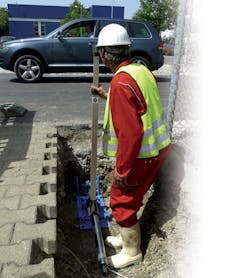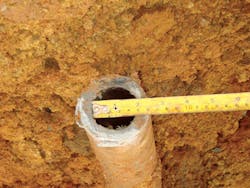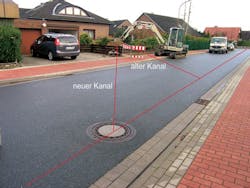The Evolution of the Water Mole: Will Open Cut Trenching be a Thing of the Past?
Technologies used for tunnelling trenches, digging or renewing pipelines have developed considerably over the last 40 years. Yet how is this market weathering the global economic storm? WWi reports on recent developments, including pipe bursting in Brazil and a new service pipeline in Germany.
Trenchless technology has come a very long way since the pioneering days of the early 1970s when primitive moles used to end up terminally lost in the shrubbery. A wide variety of highly-accurate and complementary systems, at competitive prices, are available. But is trenchless weathering the storm of the economic downturn?
Russell Fairhurst, the chair of the UK Society for Trenchless Technology (UKSTT), reports that the technologies are doing well despite the general gloom: "The benefits of trenchless are seen by all in these days of cost cutting. People are looking at how to cost carbon, and trenchless is more carbon efficient."
He explains that standard open cut involves sending spoil from trenches to landfill and importing new materials, which has environmental implications on top of the carbon penalty of the transportation involved. "Most people are looking at the benefits of trenchless," he adds. "If anything, the recession drives people more to at least look at it. The market is fairly strong and robust."
The mole's reputation
The market is no longer in its infancy, Fairhurst points out. "It has been around for 25 years, from the early moles and lining into directional drilling. Nowadays you can successfully drill and steer through hard rock. The technology is there, there is nothing to defeat it. If anyone says 'it can't be done', they are wrong."
Much depends on cost, he notes. "If open cut is too expensive, trenchless is a viable way. One of the problems we see is people who come to trade shows and say 'oh, I've seen moles, they don't work'. They may look the same but they have changed dramatically inside. They are more powerful, and more accurate."
Taking moles as an example, he notes: "They cost less than 10 years ago, thanks to the advantages of volume production. It is not a new technology any more. In real terms, allowing for inflation, they cost less. Across the industry, as volumes go up in manufacturing, prices come down."
One of the biggest indicators of how the technologies have advanced, he says, is that of the hundreds of kilometres of national grid gas line projects undertaken each year in the UK, 90% are undertaken using trenchless techniques. "And the water industry, on the clean water side, 60% to 70% is trenchless," he adds. "Uptake has dramatically increased. Now more and more are saying, what tasks can't be done?"
As examples, he points to PE pipe close-fit linings, and robot-based pipe patch repair grouting systems. It is also possible to put a robotic device into pipes as small as 200mm in diameter, he adds, trim all protruding edges, insert a liner and cut the holes for the laterals. "The quality of the robotics' camera systems is so much better, and the computer systems can measure the position for calculating the cuts."
Regarding pipe bursting, he adds, "200mm [diameter pipes] used to be considered adventurous. Now in the US they are regularly bursting 500mm pipes." With trenchless technologies being inserted down manholes or through small cores and vacuuming down to the pipe, there is so much less waste and mess and disruption that the market is increasing despite the downturn, he adds.
Market consolidation
As the market is more mature it is now highly competitive, he points out, and is driven by volume sales although quality products may attract a higher price tag. There is also a certain amount of consolidation, most notably by The Charles Machine Works, Inc (CMW) recent purchase of horizontal directional drilling (HDD) giant American Augers. The Charles Machine Works already owns several other well-known brands such as Ditch Witch and Hammer Head.
Ditch Witch Senior HDD Product Manager, Randy Rupp, says that the HDD market is soaring. "HDD systems have greatly improved and are being accepted in more and more places. The biggest advance is more power in smaller units, because of advances in hydraulics, computers, and motor technology."
Case Study: Grundobore in WildeshausenIn the German town of Wildeshausen, Tracto-Technik's Grundobore 200S was used to install a new service pipe to a house where the existing pipe had been damaged and needed frequent cleaning. Because the roadway outside the property had been renewed just two years before, open trenching would have caused damage and possibly subsidence. A decision was made to bring in a Grundobore augerbore unit to undertake the 18m link between the house and the main sewer in the road. The work began with inserting the starting "press frame" on a framework inside the 4m deep main sewer manhole at a depth of 3.3m, with the Grundobore 200S set to create a pipe gradient of 5%, crossing beneath service pipes in the pavement and the house wall foundations. The bore ended at a 1.2m by 1.2m pit, 2.5m deep, which was also used for the final house connection. The Grundobore was able to take a 250mm diameter core from the manhole shaft wall, then after a change of tool to a steering head with an integrated sonde (which sends comprehensive information about the device's position), the pilot bore was undertaken. To ensure the 5% grade was maintained throughout, the Grundobore's inclination, depth, position, direction and the roll angle of the bore head had to be constantly checked and corrected if necessary, using a hand-held receiver to pick up the sonde signals. This pilot bore was then expanded in the opposite direction using a winged bore head. Spoil produced during the bore was taken via a spiral conveyer back to the excavated pit. After this, the final pipes were pushed in from the manhole. To give an idea of the time involved, the pilot bore took just one hour. |
Basically, these units need to be able to thrust in order to steer, and rotate to drill straight, and require drilling fluid to lubricate the bore and protect the drill rods. It is remarkable to think that some HDD systems can now drill through rock.
"In the past, to do this you had to use a very large unit and a mud motor, which is driven by fluid that turns the bit – hundreds of gallons of fluid," he explains. "A few years ago we invented the All Terrain, which has the same power but is a much smaller drill rig. The AT30 HDD unit is small enough to set up in a city, yet it will drill through solid rock."
Advance electronics
Overall, Rupp notes, the HDD market is growing and the technique is becoming more accepted. "More and more civil engineers are designing jobs for HDD rather than open cut due to the lack of disruption and ease of restoration." A major selling point is the ability to do large jobs in rough ground or crowded situations without disruption, he adds.
Another great advance in the past few years has been in the walkover tracking electronics. "To guide the directional drill there is a beacon in the boring head. The tracker tells you how deep the head is, the pitch – up or down – and the direction. In the past this would be able to detect down to 30ft max – now the system allows you to go down to 100ft, which has dramatically increased the places we can go."
Indeed, Ditch Witch has just introduced its new TK Series HDD guidance system, which uses a dual locating method, four frequencies in a single beacon, and a maximum depth range for the most powerful version of up to 110ft (33.5m), as well as a high-contrast graphical display. There are three trackers in the range – a single-frequency tracker ideal for smaller rigs and relatively short bores; a dual-frequency tracker for medium rigs and standard bores, and a four-frequency tracker ideal for large rigs and long bores.
The North American market – Canada and the US, the home of HDD – are both currently strong, he says, mainly because of the boom in oil exploration and the need to bring power, water, and sewerage to remote areas. Another increasing tendency is for contractors to work across sectors rather than, as in the past, concentrating on one. "You can use the systems for multiple applications and this has made the industry more stable – if there is a dip in one industry, they can maintain their income."
Pipe-bursting in Brazil
Pipe bursting, to coin a phrase, is also a fast-expanding business. Tracto-Technik's (TT), Grundoburst pipe burster has been used in the Brazilian city of Campinas, one of the largest in the country and known as its Silicon Valley. In some districts the water authority, Sanasa, was facing ongoing potable water losses in the 30-year old pipe network. For economic, ecological and time considerations, the decision was taken to completely renew the damaged pipelines rather than repeatedly repairing them, so Sanasa bought a Grundoburst 400G3 unit – the first water authority in Brazil to do so.
Jorge Dequech of Sondeq, TT's Brazilian distributor, says that the Brazilian no-dig market is growing slowly compared to the size of the country. He notes: "Just a small proportion of jobs use no-dig methods, mostly in urban areas. But much progress has been made over the past 10 years and now, for example, HDD is a well-known and very often used method in big cities, mostly for telecoms and gas. Water is starting to use no-dig technologies."
He adds: "The biggest cities – the biggest water companies - have been using moles for house connections for a while, but when you consider the distribution mains there's still much to do. Grundoburst is getting more jobs, but the issue is changing small diameter water pipes. The Grundoburst solution with the small D35 mm rods helps with this, but we're still at the beginning. Grundoburst hasn't reached sewers so far due to the priority on solving water losses in bad water pipes first. Sewers will be the next step."
The original pipes in the Sousas district were asbestos cement, which are perfect for bursting. This district was chosen as the pilot, and around 2.4km of defective pipeline was replaced within 20 days. Sanasa plans further pipe rehabilitation in Campinas using its Grundoburst unit.
Dequech adds that there is a huge demand to exchange asbestos cement pipes with PE using pipe bursting. "Over the last two or three years water companies have faced a lot of problems. Our water pipes are pretty small, with a lot of house connections. The main problem is to push in the rod and pull it back, which is why TT has a special feature to do that, and that is why they do it successfully."
Sao Paulo is being particularly adventurous, he adds, and is planning to change all its asbestos-cement pipes – hundreds of kilometres in total - using pipe bursting.
Prices go Down Under in Australia
Among the many trenchless techniques pipe lining is one of the oldest and most popular. Infrastructure giant Aegion Corporation, Insituform's parent, announced in January that its local subsidiary had won three separate contracts with a combined value of AUD$8.9 million from Queensland Urban Utilities in Australia. Insituform Australia is installing the company's cured-in-place (CIPP) pipe as well as its jointless, small diameter iPlus Infusion and extra stiff, fibre-reinforced iPlus Composite lining technologies, with all three projects due for completion by mid-2013. Some installations are planned for Brisbane's Central Business District (CBD) and these will be undertaken at night to minimise disruption. However, proving the level of competition in this particular market, Insituform Australia lost out on another major contract, revealing that it was not among the lowest bidders for the recent Sydney Water four-year tenders. Dan Gamboa, vice president of Aegion's Asia-Pacific water and wastewater group, said in a statement: "It was disappointing to see how far prices dropped during the bidding process. Acquiring these projects at such low bid margins would have put is in a difficult position to realise adequate profits from these projects."
UKSTT chair Fairhurst cautions that despite the positive signs there is still an uphill task ahead for trenchless technologies. "One of the society's roles is about education. I still feel there is a lack of information to allow us to confidently promote trenchless solutions – even around the world the kind of information is not available to say you can do a 500mm pipe burst in particular ground conditions," he says. "The calculations are not available. Consultants say trenchless is cost effective and environmentally good, but engineering-wise they can't support this with calculations, so the client has to take the risk."
Author's note: For more information on companies and products featured in this article, email WWi at [email protected].








